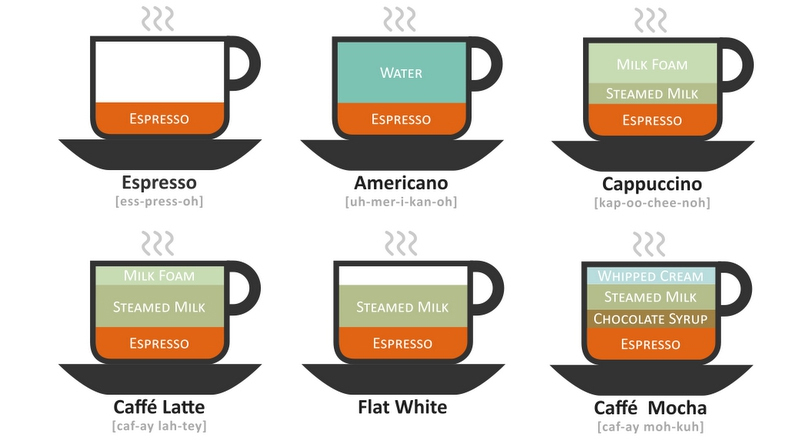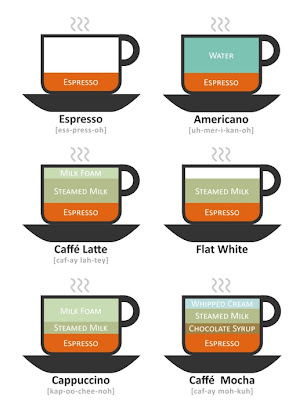
Types of coffee drinks
For a summary scroll down to the bottom.

Time to clear up all the confusion about all those different types of coffee. I'm talking about the different options you can order at Starbucks or Costa. How many types of coffee can there be? Let's think about what goes into a coffee:
- coffee itself
- hot water
- optional: milk or cream (or both?)
- optional: sugar
Also, the size or a coffee can be important, but let's get to that later.
I think that a black coffee, that is, one without milk or cream, is known as an americano. What does that word mean? Coffee names come from Italian. Let's use google translate to find out:
Ok, so it wasn't hard to guess that Americano means American, but I had to make sure. Presumably, American coffee drinkers like theirs black (at least, more so than Italians do).
Now I know from my experiences in places like Costa, there's quite a few other types of coffee, with Italian names. I can't remember them though. But I'm going to guess how they're made.
- no milk / cream = americano
- with milk = ?
- with cream = ?
Ok, so I can't get far like this. I'll put my hand up though and admit that I know of espressos, which are small coffees, served rather like shots of alcoholic spirits.
I've reached the limit of my knowledge, so it's time to pull out the revision book (or use Costa's website) and see what the main types of coffee are:
Allow me to rearrange according to my liking:
Short (small) coffees:
- espresso
- espresso doppio: 2x strong
- ristretto: even shorter than an espresso, but with the same amount of coffee
- macchiato: expresso with milk
Large coffees:
- americano: watered down espressos, with optional milk
- cappuccino: espresso diluted with milk
- mocha: espresso with a hot chocolate (and milk)
- caffe latte: coffee & milk (not as strong as the others)
- flat white: fuck knows. Sounds like it's diluted with milk, which would make no different to a cappucino.
This is confusing me so let's use a different source, the Starbuck's website.
For the espresso it says, 'this is the very essence of coffee, in its most concentrated form'. I like that definition. So we can think of an espresso as the starting point for all other coffees. (By the way, I guess starbucks haven't heard of Costa's ristretto then?)
For caffe latte is says it's made from milk, a shot of espresso, and a light topping of foam. We're using foam as an ingredient as well now?? There are a more ingredients in coffees than I realised. Foam is an important one (at least for us as we try to distinguish between these different types) since the cappuccino according to Starbucks is an espresso with milk and a half cup of foam. Not just a light topping of foam anymore, we're talking about going crazy with the foam and using a half cup.
Let's put together the information from the Costa site and Starbucks site, as well as translations provided by Google translate:
I was right about the americano being a coffee without milk - but I didn't expect the other large coffees to be almost completely made from milk. Instead of adding boiling water to their coffee granules, the Italians add steamed milk. So unless you make your coffee this way, you drink americano coffee without even knowing it.
I'm still slightly confused about the difference between cappucinos, caffe lattes and flat whites. It seems to come down the amount of cream/foam (foam, by the way, is foamed milk). A cappucino (perhaps the most popular type of coffee) is made from milk and has 1/2 a cup of foamed milk - quite a lot of foam there. A cafe latte has only a 'topping' of foam. And a flat white has no foam at all - hence its name. So the amount of foam is important in coffees.
Hopefully that's cleared the matter of coffees up. If you've read all of this post, perhaps you'll need one.
Summary



Leave a comment